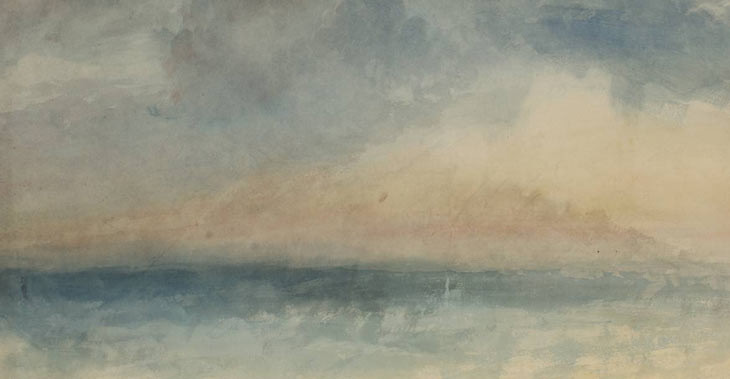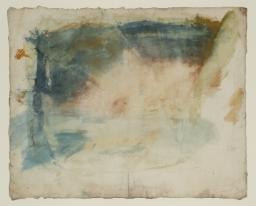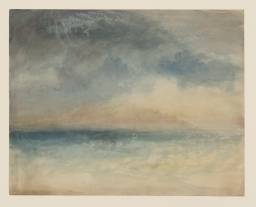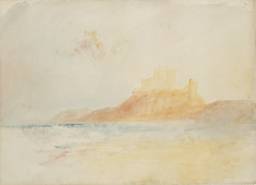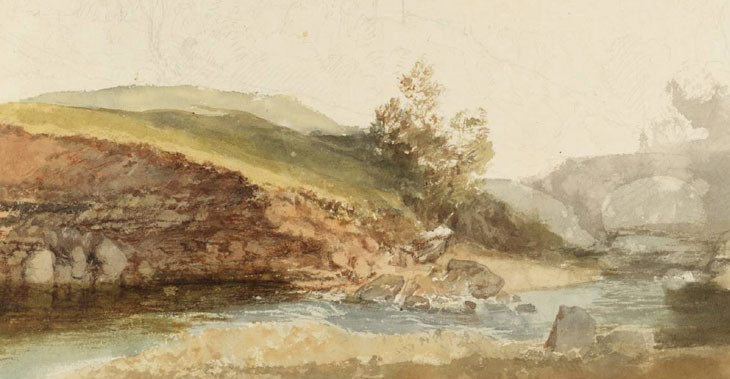Studies Relating to ‘Bamborough Castle’ c.1837
From the entry
This section comprises five watercolour studies or ‘colour beginnings’, made in connection with a large finished watercolour of Bamburgh Castle (‘Bamborough’ in earlier sources), which stands on the coast of Northumberland between Alnwick and Berwick-upon-Tweed. Essentially Norman in form but with an extensive earlier history, its gradual decline had been reversed by partial renovation in the 1750s and its use as a shelter for shipwrecked sailors and as a base for a system of warning and rescue in case of shipwrecks along the adjoining coast. Since the nineteenth century it has been in private family ownership and much restored. Turner had been at Bamburgh on his tour of northern England in 1797, between visits to the nearby coastal sites of Dunstanburgh Castle and Holy Island (see under Tate D08118 and D08115 respectively; Turner Bequest CXVI Q, N). He recorded it in the North of England sketchbook, from the south (Tate D00955, D00956; Turner Bequest XXXIV 47, 48) and from the north ...
References
This section comprises five watercolour studies or ‘colour beginnings’,1 made in connection with a large finished watercolour of Bamburgh Castle (‘Bamborough’ in earlier sources), which stands on the coast of Northumberland between Alnwick and Berwick-upon-Tweed. Essentially Norman in form but with an extensive earlier history, its gradual decline had been reversed by partial renovation in the 1750s and its use as a shelter for shipwrecked sailors and as a base for a system of warning and rescue in case of shipwrecks along the adjoining coast. Since the nineteenth century it has been in private family ownership and much restored.2
Turner had been at Bamburgh on his tour of northern England in 1797, between visits to the nearby coastal sites of Dunstanburgh Castle and Holy Island (see under Tate D08118 and D08115 respectively; Turner Bequest CXVI Q, N). He recorded it in the North of England sketchbook, from the south (Tate D00955, D00956; Turner Bequest XXXIV 47, 48) and from the north (Tate D00957; Turner Bequest XXXIV 49). The castle is possibly the subject in two designs in the subsequent Studies for Pictures sketchbook (Tate D03995, D04117; Turner Bequest LXIX 2, 102) and he passed the castle by sea in 1822, making small sketches in the King’s Visit to Edinburgh sketchbook (Tate D17652, D17653, D17660; Turner Bequest CC 82, 82a, 86).
Although he made numerous finished view of Dunstanburgh,3 Turner did not use Bamburgh as a subject for some four decades until showing his watercolour Bamborough Castle (private collection) at the Graphic Society, London, in 1837.4 Based on the 1797 sketch from the north (D00957), which includes a beached (and possibly wrecked) two-masted boat,5 it shows the castle high on the cliffs, with its keep in an eerie light before dark, billowing clouds, against which a bright signal rocket is ascending. A boat struggles among the crashing waves below, observed by crowds on the beach and two more prominent figures with a boathook in the foreground. This was to be the last watercolour Turner sent for public exhibition, when it was declared ‘one of the finest water-colour drawings in the world’;6 it also appeared in the great Manchester Art Treasures exhibition in 1857 (331), but when it was auctioned from an American collection in 2007 it had not been seen in public since the Royal Academy Old Masters exhibition of 1889.
Bamborough Castle measures 505 x 705 mm, with some scratching out and touches of gouache in addition to the watercolour, on three laminated sheets of white wove paper bearing two ‘B E & S | 1827’ watermarks.7 Eric Shanes observes that ‘not surprisingly, given its size’,8 Turner made colour studies for it. Compared to the finished work, two of the five catalogued here are a little smaller (Tate D25456, D25457; Turner Bequest CCLXIII 333, 334) and bear ‘C Ansell | 1828’ watermarks, while two are somewhat larger (Tate D25506, D36321; Turner Bequest CCLXIII 382, CCCLXV 30). D25506 has an 1825 Whatman watermark, but D36321, the closest compositionally to the finished watercolour, bears a similar 1827 Bally, Ellen and Steart watermark, as noted in its individual entry. D25505 (Turner Bequest CCLXIII 381) is not watermarked.
Given these somewhat earlier watermarks, there is room for speculation as to the exact date of the finished watercolour,9 but for consistency 1837 is given here as the approximate date of the four studies. David Blayney Brown has suggested that the subject may have been a late candidate for Turner’s Picturesque Views in England and Wales (published as engravings 1827–38),10 although its format is much larger than that generally employed for the watercolours in the series. Numerous ‘colour beginnings’ (mostly from Turner Bequest section CCLXIII) relating to England and Wales in various degrees are considered in an earlier section of the present catalogue.
See Eric Shanes, ‘Beginnings’ in Evelyn Joll, Martin Butlin and Luke Herrmann (eds.), The Oxford Companion to J.M.W. Turner, Oxford 2001, pp.21–3.
See Hill 1996, pp.78, 188; see also ‘History’, Bamburgh Castle, accessed 23 November 2012, http://www.bamburghcastle.com/history.php .
Andrew Wilton, J.M.W. Turner: His Life and Work, Fribourg 1979, p.404 no.895 as ?c.1840; see Turner Society News 2007, p.1, reproduced in colour.
Exhibition catalogue, Graphic Society, London 1837, quoted in Hill 1996, p.78; see also p.200 note 30.
Sotheby’s, London, 5 December 2007 (76); see auction catalogue entry, Sotheby’s, accessed 23 November 2012, L07033.html+r.m=/fr/ecat.lot.L07033.html/76/">http://www.sothebys.com/fr/catalogues/ecatalogue.html/2007/old-master-paintings-evening-sale-l07033#/r=/fr/ecat.fhtml.L07033.html+r.m=/fr/ecat.lot.L07033.html/76/.
Revised September 2016
How to cite
Matthew Imms, ‘Studies Relating to ‘Bamborough Castle’ c.1837’, November 2012, in David Blayney Brown (ed.), J.M.W. Turner: Sketchbooks, Drawings and Watercolours, Tate Research Publication, December 2012, https://www

